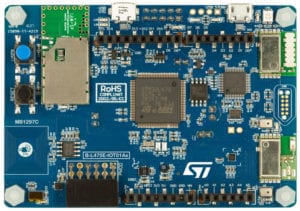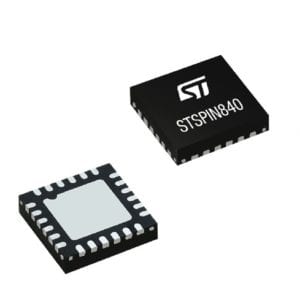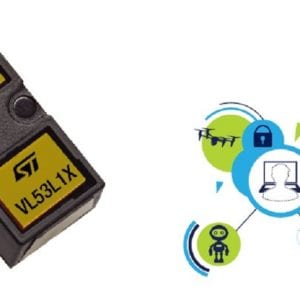STM32 Step-by-Step is the first initiative focusing on making our STM32 development platforms and microcontrollers (MCUs) accessible to all enthusiasts and professionals by offering a step-by-step beginner’s guide. This five-part tutorial walks users through the installation of the essential tools developers need to program their STM32 embedded systems, such as STM32CubeMX, and the TrueStudio IDE, to name a few. Using a NUCLEO-L476RG or an STM32L4 Discovery kit IoT node (B-L475E-IOT01A) as examples, it will teach readers how to set up their MCU, launch a blinking light application, then present critical concepts such as UART, sensors, and mobile apps using Bluetooth. Hence, the knowledge and experience that users gain go far beyond a cursory introduction as it leaves them with the tools they need to start their personal and complex projects.
STM32 for All

2018 continues to be a fantastic year for ST Technologies in Universities. The course Introduction to Embedded System with SensorTile from UCLA led to the creation of impressive student projects that relied on our components and Machine Learning to increase the performance of tennis and basketball players, as well as helping nurses perfect the removal of catheters to improve patient care. STM32 Step-by-Step builds on this tradition to bring embedded systems to even more people by making this course free and accessible to all. It is part of our STM32 Education initiative, which groups training, Massive Open Online Courses (MOOC), videos, textbooks, and many more resources under one roof to help anyone gain the expertise in STM32 platforms and embedded systems, thus bringing experience and knowledge to the next generation of visionaries.
Before publishing STM32 Step-by-Step, we submitted our tutorials to various post-secondary schools, such as the École Centrale de Marseille, to gauge the students’ reactions to the coursework and iron out issues that could confuse or slow them down. One of the biggest challenges was figuring out what to expect from readers. We relied on our technical engineers to write each of the five modules because of their experience with our platforms and with our new customers. However, it was imperative to deal with the tough question of the courses’ prerequisite, because we tailor to such a wide range of developers. We settled on a middle ground that requires a cursory knowledge of C while we walk readers through every aspect of our solutions.
No ST Software Left Behind
The course will bring up our STM32Cube Expansion Packages, more precisely the X-CUBE-MEMS1 and X-CUBE-BLE1, which help teams jump start their projects. Today, the vast majority of our expansions contain folders to export source codes quickly to the most popular development environment, and we are committed to supporting these alternatives. However, since STM32 Step-by-Step is targeting beginners, we assume that readers are not familiar with these tools and may be hesitant to invest in expensive toolchains. As a result, our tutorials use TrueSTUDIO, a free and feature-rich IDE, which reduces the barrier to entry and ensures all users have a shared experience that will help them progress faster.
Additionally, STM32 Step-by-Step also guides users through the major pillars of our ecosystem and teaches them to expertly use all our software components. Just like Nwave and PNI, both impressive makers of smart parking sensors, readers will learn how to use STM32CubeMX and grasp the immense value of its graphical interface as they configure the pin-outs, clock tree, and peripherals of their microcontroller. They will also install STM32CubeProg, a development tool that makes it easier to read, write and verify the MCU’s memory, thanks to its intuitive Graphical User Interface (GUI). Finally, some of the tutorials will use STM32Cube packages to show how our drivers, source codes, and application examples can genuinely speed up developments.
Never Alone with STM32 Step-by-Step

Another fundamental aspect of STM32 Step-by-Step is our new Community. Throughout the years, many members expressed the desire to learn how to start programming on our platforms and this new initiative gives them the expertise. Moreover, we have a thread specifically for this project, so users can ask questions to our engineers and most knowledgeable contributors. This is the best testimony of what it means to belong to the ST ecosystem as it shows that we are not only making our products more accessible but that we also follow users on their journey to assist them in their various challenges. To further increase collaboration between our readers and the community, we are even shutting down the comments section on this post to ensure that all questions get to the STM32 Step-by-Step thread.
This support aspect is particularly crucial for us because we understand that no matter how much we hold the readers’ hand, embedded systems can be complex. For example, the third module on UART is a masterclass on one of the most popular communication protocols in the industry. Each component of this chapter shows precisely how to use CubeMX to configure the MCU’s pinout, and then use the TrueSTUDIO toolchain to send a “Hello World!!!” message that developers can view in a terminal, making this section one of the most fundamental building blocks for a future project. However, the Community is here to help anyone who may run into trouble because of a misunderstanding or to encourage the students who want to ask further questions about the topic. UART is a crucial concept, and we want to use the Community to reward the students’ perseverance and curiosity.
Walking the Talk
Users who go through the five modules of our new course have thus the assurance that they are becoming expert developers in the ST technologies that many of our customers and success stories also use. What makes this coursework special is that it brings the same powerful solutions to the masses. STM32 Step-by-Step is a door for anyone looking into the embedded revolution, and we can’t wait to see you on the other side.




